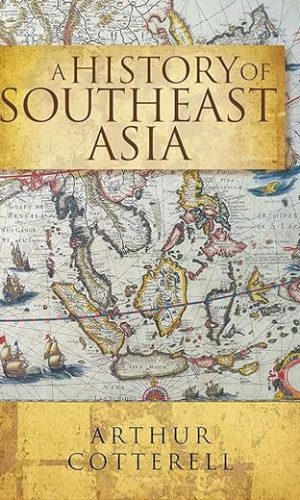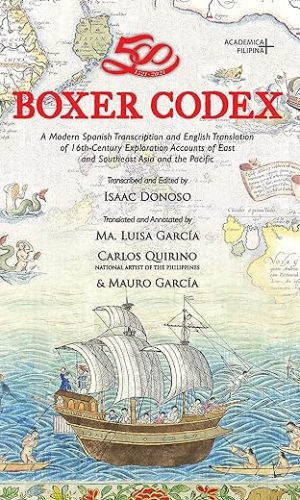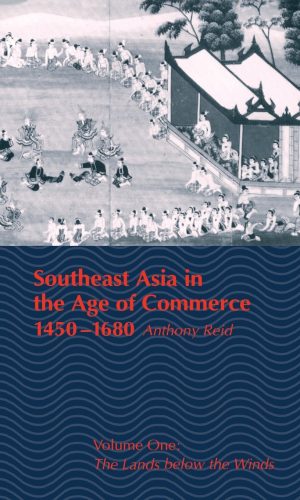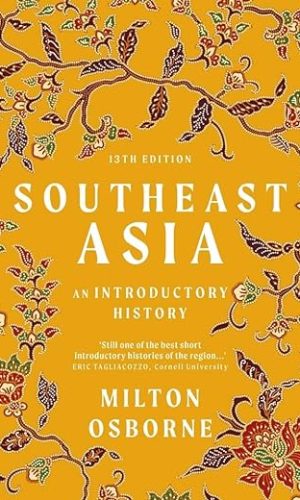South East Asia
-
A History Of South East Asia,
A History of Southeast Asia narrates the history of the region from earliest recorded times until today, covering present-day Myanmar, Thailand, Cambodia, Laos, Vietnam, Malaysia, Singapore, Brunei, the Philippines, Indonesia and East Timor. Concisely written and filled with historical anecdotes of key individuals and events, this authoritative volume is presented in three parts, covering both mainland and maritime Southeast Asia: *Part 1 – Early Southeast Asia (the earliest civilizations)*Part 2 – Late Southeast Asia (including the colonial period)*Part 3 – Modern Southeast Asia (the present-day era, following the Pacific dimension of the Second World) Superbly supported by over 200 illustrations, photographs and maps, this volume provides real insight into one of the world’s most distinctive but complicated regions, at a time when Asian countries are beginning to set the pace in the global economy.Read more
£16.20£19.00A History Of South East Asia,
£16.20£19.00 -
A Short History of South-East Asia
Explore the fascinating history of south-east AsiaA Short History of South-East Asia, Sixth Edition is the latest in a series of updated texts spotlighting this fascinating region. With revised chapters for all of the countries in this geographic area, this interesting text paints a remarkable overview of the characters and events that have shaped this part of the world. Founded upon a deeply perceptive observation of the late founding Prime Minister of Singapore Lee Kuan Yew, this book brings shape to the idea that ‘to understand the present and to anticipate the future, one must know enough of the past, enough to have a sense of the history of a people.’ With an approachable writing style and comprehensive content, this unique text was written for business readers interested in improving their understanding of this important region.
With globalization continuing to gain momentum, south-east Asia is emerging as an important business sector for many industries. Not only does this open up professional opportunities, it exposes individuals in other parts of the world to the unique histories and cultures of the area. If you are interested in learning more about the region, this abbreviated text is a wonderful resource.
- Explore historic and political developments that have taken place throughout south-east Asia
- Quickly navigate text organized by country, allowing you to dive into the events that have shaped Brunei, Cambodia, East Timor, Indonesia, Lao PDR, Malaysia, Myanmar, the Philippines, Singapore, Thailand, and Vietnam
- Gain an important global perspective, which can prove valuable on personal and professional levels
- Leverage your new understanding of the region’s past to better understand its present and anticipate its future
A Short History of South-East Asia, Sixth Edition is an abbreviated history of south-east Asia written with business readers in mind.
Read more
£17.10 -
Boxer Codex (Academica Filipina+)
In 1947, colonial Iberian maritime scholar Professor Charles R. Boxer acquired a late sixteenth-century manuscript written by an anonymous scribe who had compiled several eyewitness accounts of both Spanish and Portuguese expeditions to Asia and the Pacific. Through detailed descriptions and lavish illustrations, this manuscript depicted the customs, costumes, and ways of life of the various peoples of East and Southeast Asia, particularly the Philippine Islands. In the decades since the book came to light, an international constellation of scholars the world over has expanded our understanding of this valuable document and given us the clearest depiction of the lives of newly colonized Filipinos and the politics of early modern Asia. As such, the Boxer Codex is indispensable in understanding both Iberian and Asian encounters at a pivotal time in world history.
Now this invaluable work is made accessible to a new generation of Filipinos and scholars with this bilingual edition, written in modern Spanish and English. It also marks the beginning of the commemoration of 500 years of Philippine-Spanish encounters from 1521 to 2021. An extensive introduction situates this work in a global context and presents the intertwined histories of academician Charles Boxer and Philippine National Artist Carlos Quirino, whose friendship ignited global interest and passionate study of the codex.
Read more
£10.30 -
Southeast Asia in the Age of Commerce 1450–1680 – The Lands Below the Winds V 1 (Paper): Volume One: The Lands Below the Winds (Revised)
In The Lands below the Winds-the first volume of a two-volume set chronicling the rise of Southeast Asian culture during the years from 1450 to 1680-Anthony Reid vividly explores everyday life in the different societies of the region, from diet, housing, commerce, and law to sexual and family relations, patterns of warfare, and popular entertainment. In so doing he enables us to perceive the underlying coherence and splendid variety in the complex mosaic of Southeast Asia. “Anyone interested in Southeast Asian history should read, teach, and learn from this enthralling, fastidious book.”-David P. Chandler, Journal of Asian Studies “There is nothing that catches better the general look of things on the eve of European hegemony or evokes more effectively what Southeast Asia was like when Southeast Asians themselves bestrode it.”-Clifford Geertz, New York Review of Books “An outstandingly readable example of its genre, a superb unrhetorical portrayal of its society and period. One can scarcely wait for the sequel.”-E.L. Jones, Asian Studies Association of Australia Review “A model of ‘total history.’ The level of synthesis, judgment, and insight are so high as to entirely reconstruct our understanding of pre-colonial Southeast Asia.”-James C. Scott, Yale University “It is the most important study in the field for many years; it is likely to set the agenda for research in the field for many years to come.”-Norman Owen, All Asia Review of BooksRead more
£47.90 -
Southeast Asia: An introductory history
The first edition of Southeast Asia: An introductory history was published in 1979 and immediately filled a need for travellers and students interested in a tantalisingly different part of the world. Subsequent editions (translated into Japanese, Khmer, Korean, Chinese and Thai) have continued to document with great perception the enormous changes and dramatic growth experienced in the region.
Dr Milton Osborne has been a resident, student and fascinated observer of Southeast Asia for many years. This familiarity has resulted in a highly readable and lively chronicle. While giving due regard to the early history of the region, Osborne concentrates on the changes that have taken place since the 18th century: the impact of colonial rule, the economic transformations of the 19th and 20th centuries, the emergence and triumph of the independence movements, the impact of social change and the pivotal roles played by religion, ethnic minorities and immigrant groups. He also provides an introduction to the art of the region and a comprehensive guide to literature about Southeast Asia.
Clearly written and extensively illustrated Southeast Asia: An introductory history remains a classic in the field.
‘Still one of the best short introductory histories of the region…’ Eric Tagliacozzo, Cornell University
Read more
£7.60£10.40Southeast Asia: An introductory history
£7.60£10.40 -
The Borneo Confrontation: Volume 1 – Indonesian-Malaysian Confrontation, 1963-1966: 44 (Asia@War)
The aftermath of the Second World War saw many colonial empires in a state of upheaval. In South East Asia, what had been armed resistance against the Japanese invaders and occupiers was now often turned into national liberation movements seeking independence from the European empires. The Second World War may have ended but this was anything other than an era of peace. This was an era in which Britain moved between successive crises in Palestine, Kenya, Cyprus, Suez and the wider Middle East, in addition to fighting a conventional war in Korea, maintaining a significant peacetime army in West Germany and Berlin, and honoring commitments to the South East Asia Treaty Organization.Volume 1 of Borneo Stand-off examines the background, context and origins of Britain’s military experience in post-Second World War South East Asia as Malaya transitioned from colony to the independent state of Malaysia, up to and including the Brunei Revolt of 1962, and sets the scene for the coming Confrontation – or Konfrontasi – with the Indonesia of Sukarno, buoyed by his recent successes against the Netherlands in the former Dutch East Indies.
Borneo Stand-off Volume 1: Seeds of the Confrontation and the Brunei Revolt of 1962 is illustrated throughout with photographs, and includes color artworks of the men, vehicles and aircraft of the era of Confrontation.
Read more
£16.20£19.00 -
The Khmer Empire: The History and Legacy of One of Southeast Asia’s Most Influential Empires
*Includes pictures
*Includes contemporary accounts
*Includes online resources and a bibliography for further reading
The Khmer Empire, also known as the Angkor Empire, was a powerful empire of Southeast Asia that was established in 802 CE and ended in 1431 with the invasion of the Siamese and abandonment of Angkor. The Khmer Empire was responsible for many of the historic monuments and temples found throughout the jungles of modern-day Cambodia, and also in other countries of Southeast Asia, all made possible by the fact the Khmer Empire reached across modern-day Cambodia, parts of Thailand, Laos, and Vietnam, making it a strategic trading partner with ships traveling from China and India.
Of all the architecture, the empire is best known for constructing Angkor Wat, one of the modern world’s greatest wonders. Known in English as Angkor Wat (“City Temple”), the gigantic complex was built by King Suryavarman II in the early 12th century to serve as the king’s state temple and capital city. Since it has remained so finely preserved, it has maintained religious significance for nearly 900 years, first dedicated to the Hindu god Vishnu, and then Buddhist. Understandably, it has become one of Cambodia’s most potent symbols and tourist attractions, and it even appears on the Cambodian national flag. Angkor Wat continues to fascinate the world, both due to its sheer grandeur and size, as well as its ornamental decorations both inside and out. With political strife in Cambodia having cooled, Angkor Wat is now a major tourist attraction, bringing upwards of over half a million foreigners per year, which accounts for over half of the nation’s tourists.
As a result, the long-lasting influence that this empire had on the people of Cambodia can still be felt today, with Angkor Wat being featured on the national flag. The Khmer Empire: The History and Legacy of One of Southeast Asia’s Most Influential Empires chronicles the remarkable history of the Khmer and their impact on the region. Along with pictures depicting important people, places, and events, you will learn about the Khmer Empire like never before.Read more
£8.30







